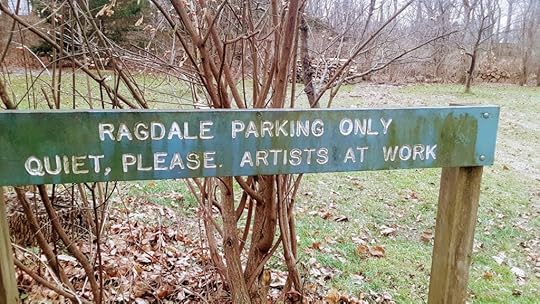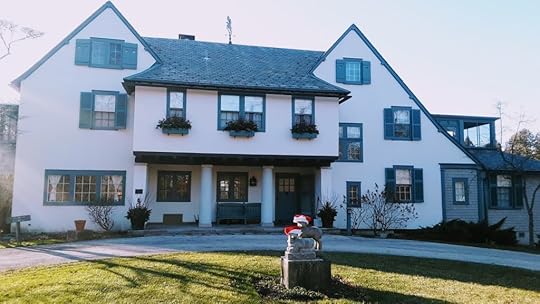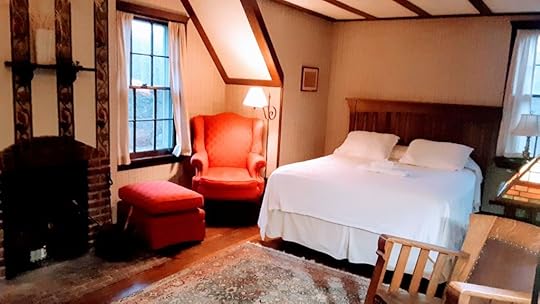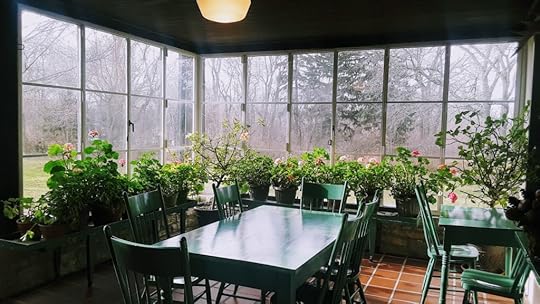Ragdale: The Delights of Having a Room of One’s Own

From the moment I first declared myself
a novelist in my twenties, there were doubters. My father, for
starters. “You’ll never make a living. Why don’t you be a nurse?”
he said. “Or a dentist! They make good money.”
Various boyfriends doubted me as well.
“Are you still writing fiction?” they asked. “Why are you
writing, if you never sell anything?”
And, of course, I was my own biggest
doubter. Why did I keep writing fiction, if I never sold
anything?
It wasn’t easy. I had children, a
husband, a mortgage, car loans. Then a divorce, another husband,
stepchildren, a baby of our own. Job layoffs for him, startups that
failed, lots of scrambling by both of us. College tuition looming.
Retirement plans? Ha. We’ll be working until we’re 110.
Yet, I kept writing fiction. For
decades, I wrote fiction at night after meeting my work obligations,
at weekend track meets and skate parks and gym classes. I wrote in
the car and in the occasional cheap hotel room when I could get away
alone for a weekend. At home, I wrote in the dining room, out on the
porch in good weather, or in the living room when it’s cold, on an
old table by the radiator.
I breathe, therefore I write. That’s
the nature of being an artist, isn’t it? You keep doing it because
you can’t help yourself.
And, every now and then, if you’re lucky, you are validated. Maybe you have good feedback in a writers’ workshop. Maybe you sell something. (I did sell novels, eventually.) Or people email to say they were moved by your essay or helped by your article. That can keep you going.
But none of that validation solves the essential problem of every artist: How do you find time and space to think clearly and create new work, in the midst of life’s many obligations and distractions?
For women artists, particularly mothers, this is the question that none of us has figured out how to answer, unless we’re lucky enough to be wealthy. As Virginia Woolf said so plainly, “A woman must have money and a room of her own if she is to write fiction.”
That’s hard to come by in this
society, where art is too often an afterthought or a luxury.
Recently, I was granted such an unexpected, extreme act of generosity
supporting my art that I’m still reeling from it. Here’s the email:
Dear Holly,
We are pleased to have this unique
opportunity to invite you to take a 4- day retreat at Ragdale at no
cost as someone highly recommended by our Curatorial Board. A gift
from an anonymous donor has allowed us to extend invitations to those
artists and administrators who would most benefit from this time.
My jaw dropped. (I knew who had
recommended me, but I won’t out her here—I know she values her
privacy.) First, I cried, overwhelmed by this tremendous gift.
No way can I go. Christmas is
coming. How can I leave? That
was my first thought, followed quickly by another: Christmas
is coming. That’s the reason to go.
Various places around the country host artists-in-residence. Here in the northeast, we have the MacDowell Colony in New Hampshire and Yaddo in New York. The point of all of them is to provide time and space for visual artists and writers to work, uninterrupted, in a supportive, communal setting. Sounds ideal, right? For men or young artists, sure. The problem for women writers like me is that most of these places require a minimum stay of two weeks. I could never get away. Never mind my paid work. Who would watch the kids?
But now my children are older. Could
it really help me, to have a room of my own at this point in my
career? Or would I flounder, especially if I were surrounded by
intimidating young talent? I could only answer these questions if I
bit the bullet and gave myself a plane ticket to Chicago for
Christmas.
Ragdale Foundation offers 200 residencies and fellowships a year to artists of all types. It’s located in an elegant 19th century home built as a summer house near Lake Michigan by architect Howard Van Doren-Shaw.

I honestly had no idea what to expect,
and was floored by the grand house, which still has its original
architectural features, and a particularly cozy enclosed porch where
giant geraniums bloom on the windowsills. I was even more impressed
by the rooms given to residents. Mine was on the second floor, a huge
space with a bedroom and sitting area, a private bathroom, a desk by
a window, and even a screened porch to use in good weather. The
windows overlooked the trails through the prairie behind the house.

So far so good. I went for a run and
had no trouble getting to work. What else could I do? No dishes, no
laundry, no work commitments awaited me. I worked until dinner, then
wandered into the building next door, which houses Ragdale’s library,
staff offices, and a communal dining room. There, promptly at 6:30
every night, delightful “Chef Linda” offers dinner, and residents
gather to eat and discuss their work. I’d expected to feel like an
outcast, since I was there only for a few days and most residents
were there for much longer, but I was immediately welcomed and folded
into the group.
If I were at home, I’d probably do laundry and watch TV after dinner, or maybe take a bath and read. Here, fired up by the dinner conversation, it felt perfectly normal to go back to my room and resume working on my novel in progress.
The next morning, I foraged for food in the kitchen downstairs—residents are provided food for DIY breakfasts and lunches—and met another woman from the area who writes YA fiction. We talked about agents and publishing markets as we ate breakfast together in that gorgeous, plant-filled sunroom. Then I went back upstairs and started writing. I didn’t get up from my desk again for over three hours, then had lunch and resumed.

I wrote until my fingers were numb
from typing, then went for a run and made a sandwich. Upstairs again,
I kept writing until dinner. After dinner, guess what? I wrote some
more and did a little research for the novel.
Are you getting the picture here? A
residency where you meet other writers isn’t intimidating. It’s
inspiring, even for experienced workhorses like me, because you’re
immersed in silence and beauty for most of the day, and when you come
up for air, there are other people who think it’s worthwhile to talk
about writing.
Having a room of one’s own and the
support of other artists, especially in this commercialized time of
year and in a country where books take a back seat to careers, TV
streaming services, online gaming, shopping, and, well, just about
everything else, isn’t just productive. It’s inspiring. A residency
like Ragdale’s, even a brief one, makes you believe not only that you
can do the work, but that the work is worth doing simply for the
sake of creating it.
I am so grateful to Ragdale’s founders and staff, to the anonymous donor who supported me, and to the woman who nominated me for the residency. I came away determined to find ways to make writing more possible for myself, even if it just means closing the door and taping a sign to it that says, “Quiet, Please. Artist at Work.”
The post Ragdale: The Delights of Having a Room of One’s Own appeared first on Holly Robinson.



